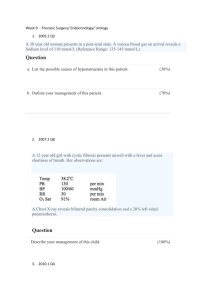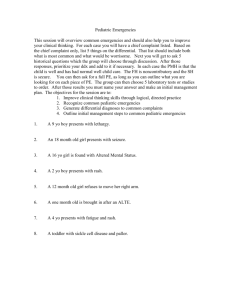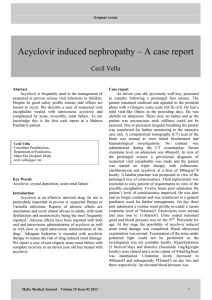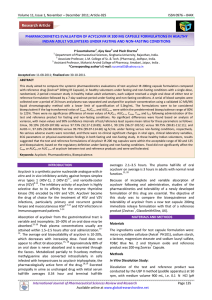Nelson – Pediatrics Nutrition 3. A 4-mo
advertisement
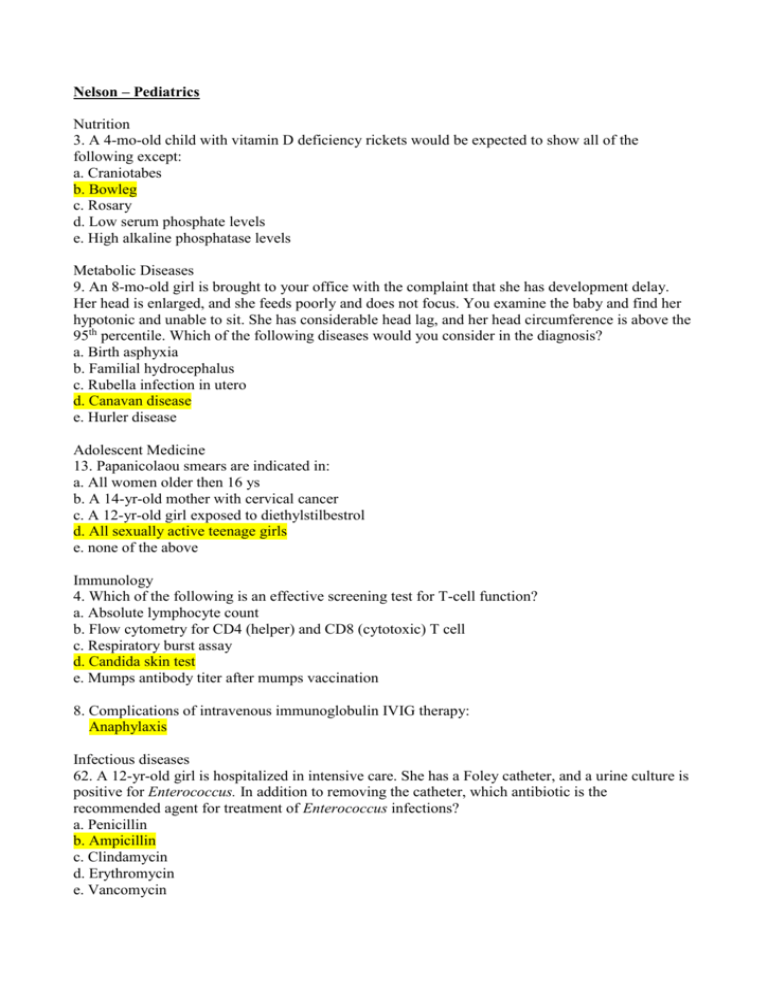
Nelson – Pediatrics Nutrition 3. A 4-mo-old child with vitamin D deficiency rickets would be expected to show all of the following except: a. Craniotabes b. Bowleg c. Rosary d. Low serum phosphate levels e. High alkaline phosphatase levels Metabolic Diseases 9. An 8-mo-old girl is brought to your office with the complaint that she has development delay. Her head is enlarged, and she feeds poorly and does not focus. You examine the baby and find her hypotonic and unable to sit. She has considerable head lag, and her head circumference is above the 95th percentile. Which of the following diseases would you consider in the diagnosis? a. Birth asphyxia b. Familial hydrocephalus c. Rubella infection in utero d. Canavan disease e. Hurler disease Adolescent Medicine 13. Papanicolaou smears are indicated in: a. All women older then 16 ys b. A 14-yr-old mother with cervical cancer c. A 12-yr-old girl exposed to diethylstilbestrol d. All sexually active teenage girls e. none of the above Immunology 4. Which of the following is an effective screening test for T-cell function? a. Absolute lymphocyte count b. Flow cytometry for CD4 (helper) and CD8 (cytotoxic) T cell c. Respiratory burst assay d. Candida skin test e. Mumps antibody titer after mumps vaccination 8. Complications of intravenous immunoglobulin IVIG therapy: Anaphylaxis Infectious diseases 62. A 12-yr-old girl is hospitalized in intensive care. She has a Foley catheter, and a urine culture is positive for Enterococcus. In addition to removing the catheter, which antibiotic is the recommended agent for treatment of Enterococcus infections? a. Penicillin b. Ampicillin c. Clindamycin d. Erythromycin e. Vancomycin 63. As a visiting physician in a developing country, you are asked to see a 2-yr-old child who presents with a history of fever, dysphagia, and lethargy. Physical examination shows a gray-brown leather-like adherent membrane over the posterior oropharynx and hypopharynx. The most likely diagnosis is: a. Epiglottitis b. Bacterial tracheitis c. Group A streptococcal infection d. Vincent angina e. Diphtheria 209. A 5-yr-old boy who lives in an urban area is hospitalized because of low-grade fever, flaccid paralysis of both legs, sensory changes, and absent ankle deep tendon reflexes. The child received only two immunizations with OPV, at ages of 2 and 6 mo. The most probable diagnosis is: a. Acute paralytic poliomyelitis due to wild poliovirus b. Paralysis due to nonpolio enteroviruses c. Vaccine-associated poliomyelitis d. Guillain-Barrè syndrome e. Tic-bite paralysis 217. Which of the following statements regarding the diagnosis of enterovirus infections is true? a. Useful diagnostic techniques are not available b. Polymerase chain reaction assay is very sensitive c. Useful diagnostic specimens are limited to throat and rectal swabs d. All enteroviruses grow well in cell culture e. Antigen detection is a useful way to detect all enteroviruses 221. Recommended management for a mother with active genital HSV infection during labor is: a. Culture of blood from the newborn, with treatment based on culture results b. Culture of blood from the newborn, with empirical acyclovir therapy c. Intravenous acyclovir treatment for the mother d. Cesarean section within 4 hr of rupture of membranes e. Intravenous acyclovir treatment for the mother and cesarean section within 4 hr of rupture of membranes 222. A 3-yr-old boy presents with a 7-day history of fever, cervical lymphadenopathy, foul breath, and painful oral lesions on his tongue, gums, and lips. For the past 3 days he has had a red, painful swollen area about the nail of his right thumb with an area of fluid by the nail bed, unresponsive to warm soaks and a first-generation cephalosporin. The most likely etiologic agent is: a. Staphylococcus aureus b. Mucocutaneous candidiasis c. Coxsackievirus d. Adenovirus e. Herpes simplex virus 326. A 5-yr-old boy with AIDS and who is receiving zidovudine, lamivudine, and ritonavir presents with rapid respiratory rate and progressive dyspnea of 2 days duration. There is no fever. The chest radiograph reveals bilateral diffuse alveolar disease. The most important diagnostic test would be: a. CT scan of the chest b. Pharyngeal swab for viral and bacterial cultures c. Blood gas profile d. Serum lactate dehydrogenase level e. Bronchoalveolar lavage for cytology 329. A 6-yr-old girl who was previously healthy presents with a 1 –wk history of nocturnal perianal itching. There are no other symptoms, and the findings on physical examination are normal. The most appropriate therapy is: a. Bacitracin ointment to the perianal area b. Diphenhydramine orally as needed for itching c. Single oral dose of mebendazole repeated in 2 wk d. A 2-wk course of amoxicillin/clavulanate e. Ketoconazole, in a single dose The Acutely Ill Child 3. During examination o fan 8-mo-old child, the difficulty of optimal chest auscultation is due primary to: a. Recent meal with gastric distention b. Rapid respiratory rate c. Stranger anxiety d. Transmitted nasal sounds e. Pliable chest wall The Cardiovascular System 7. Complications of vascular rings include all of the following except: a. Reccurent emesis b. Chronic wheezing c. Tracheomalacia d. Heart failure e. Cough Growth, Development and Behavior 4*. The best feeding protocol for a temperamentally irregular infant is: a. A fixed schedule b. One based on the parents schedule c. Every 1-2 hr d. One based on demand e. 60 min for each feeding Human Genetics 10*. A mentally retarded 15-yr-old boy is found to have macro-orchidism and large, prominent ears. The most likely diagnosis is: a. Cerebral giantism b. Acromegaly c. Hypothyroidism d. Trisomy 21 e. Fragile X syndrome Skin 21. An 8 year old girl presents with large cafe-au-lait spots with irrgular borders and precocious puberty x-ray shows polyostotic fibrous dysplasia of bone, the most likely diagnosis is : A. B. C. D. E. Neurofibromatosis McCune-albright syndrome Tuberous sclerosis Maffucci syndrome Normal child Allergy 70 nelson All if the follwing foos are characteristically associated with allergy exept : A. B. C. D. E. pneaut tree nuts legumes Egges Seafood Guys here is the answer is C , in the exam they took the expet out and add cow milk According to nelson A B D E are characteristically assoicated with food allergies Cow milk also is assoicated with alergy !!!!!!!!!!!!!!!!!1111 I think here can be more than one answer correct , lets hope!!!! *********Otitis media treatmnet in childern !!!!!!!!!!!!!!!!!!!!!
